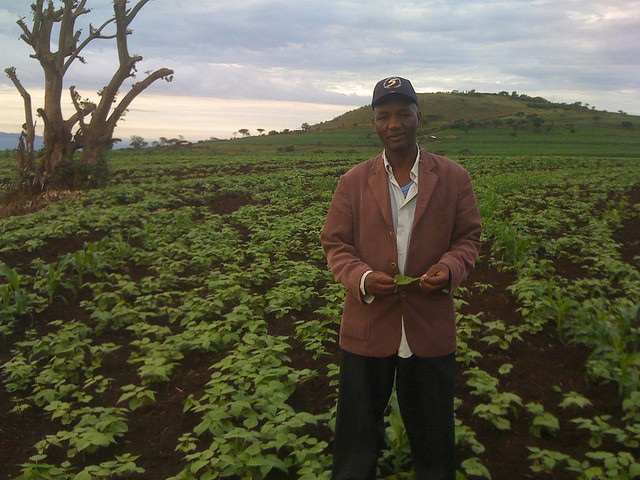In the Race to Achieve Zero Hunger and Mitigate Climate Change, We Must Look Down — to the Soil

ILLINOIS, United States, Sep 18 (IPS) - Esther Ngumbi is a post-doctoral researcher at the Department of Entomology and Plant Pathology at Auburn University in Alabama. She was the 2015 Clinton Global University (CGI U) Mentor for Agriculture and 2015 New Voices Fellow at the Aspen Institute.Recently, the United Nations Food and Agriculture Organization (UN FAO) Director-General José Graziano da Silva urged countries, scientists, policymakers and stakeholders invested in building an equitable, sustainable, and thriving planet to pay attention to the soil. He further noted that the future of the planet depends on how healthy the soils of today are.
I agree. In the race to beat food insecurity, achieve zero hunger, and address climate change, we must pay attention to the soil. The importance of soil cannot be overstated. Healthy soils underpin agriculture and sustainable food systems.
But there is more to healthy soils. They can deliver many other benefits.
First, healthy soils can help address and mitigate climate change through storing soil carbon. Research studies have shown that healthy soils hold more carbon and these reduce greenhouse gas emissions by 50-80 percent.
At the same time, research studies and reports have shown that soils that are rich in organic carbon can deliver many benefits, including increasing crop yields, soil water holding capacity and storage. Plants can use stored water in periods when water is scarce.
Secondly, healthy soils make it possible for the inhabitants of the soils —soil microorganisms — to continue playing their roles. Unseen to the naked eye, tiny soil microorganisms that include bacteria and fungi are hard at work, helping plants to grow better while keeping our soils healthy, which ultimately allows farmers to grow food amidst a changing climate.
Further, these microorganisms deliver other benefits including helping plants to tolerate climate change induced extremities including drought. These microbes can also help plants to fend off and suppressinsect pests, including invasive pests and other that have become a force to reckon with in the developing countries. Thriving and functioning soil microbes can be key to revolutionising agriculture.
Thirdly, taking care of the soil and keeping them healthy, ensures that farmers around the word build resilient ecosystems that can bounce back from extremities that come along with a changing climate.

However, even with all these benefits that come along when soils healthy, around the world, a third of our soils are degraded.
In 2015, the U.N. launched the International Year of Soils and highlighted the extent with which soils were degraded worldwide. Since then, countries, non-governmental organisations (NGOs), and many other stakeholders have stepped up to the challenge. They are paying attention to soils.
Ethiopia launched a countrywide initiative to map the health and status of Ethiopian soils which has allowed farmers to reap the many benefits that can come when soils are healthy including increased crop yields. Because of paying attention to soil health, Ethiopia is slowly transforming agriculture, and paving way for its citizens to become food secure.
In addition, in early June, the FAO together with the Global Soil Partnership launched The Afrisoils programme, with a goal to reduce soil degradation by 25 percent in the coming decade in 47 African countries.
Moreover, because soil health is not only an African problem, developed countries are stepping up.
In the United States, the Soil Health Institute continues to coordinate and support soil stewardship and the advancement of soil health. The U.S. Department of Agriculture offers tips, guidelines and many resources that can be useful to stakeholders and governments and farmers that want to help restore the health of their soils. Advocacy groups like Soil4Climate continue to advocate for soil restoration as a climate solution.
This must continue.
But, as Africa and the many stakeholders look to the future and pay attention to soils, what are some of the areas and innovations surrounding soils that are likely going to pay off?
Innovations surrounding beneficial soil microbes. When beneficial soil microbes are happy, healthy, and plentiful in the soils, the nutrients are available to roots, plants grow big, insects are repelled and farmers ultimately reap the benefits—a plentiful harvest.
We must ensure that products and solutions that spin off from beneficial soils microbes are affordable, especially so to the over 500 million smallholder farmers, who live on less than a dollar a day.
Innovations surrounding soil heath diagnostic kits that help farmers to rapidly and precisely determine the health of the soils will be a win-win for all.
As shown in Ethiopia, where knowing the status of the heath of the soils has resulted into the doubling of farmer's productivity and improving soil health these innovations can be a game changer in the race to beat food insecurity across Africa.
Translating innovations into products and solutions requires funding. Luckily, innovators, researchers, NGO's and for profit companies thinking of making this happen can apply for funding through FoodShot Global's Innovating Soil 3.0 challenge.
This unique investment platform catalysing groundbreaking innovation to cultivate a healthy, sustainable and equitable food system will be offering a combination of equity and debt funding to innovative businesses and a groundbreaker prize of more than USD500,000 to researchers, social entrepreneurs and advocates taking bold "moonshots for better food".
These cash prizes will allow winners to translate bold ideas that utilise the latest in technology, science and engineering into solutions that address the soil health crisis.
To reap the many benefits that come along with healthy soils, the right interventions and innovations to improve soil health must be funded, rolled out and scaled up. Healthy soils are the foundational base that will enable countries to achieve the U.N. sustainable development goals. In the race to achieve these goals, we must pay attention to the soil. Time is ripe.
© Inter Press Service (2018) — All Rights ReservedOriginal source: Inter Press Service
 Global Issues
Global Issues